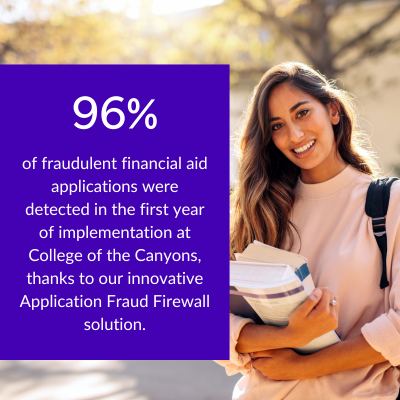Who is Behind the Computer?
Who is Behind the Computer?
Ghost students are plaguing colleges and universities. Here’s what they can do about it.
Scammers posing as fake students are inundating colleges across the U.S. with fraudulent applications. Using stolen or fabricated identities, these “ghost students” successfully enroll, only to disappear—taking with them financial aid funds and official college-issued email addresses.
Ghost students tie up seats in course sections, sap financial aid award funds, and create administrative nightmares for understaffed admissions offices. Additionally, since the fraudster now owns a school ID and email, they become an insider threat.
Despite growing awareness of the problem, many colleges still lack the real-time analytics, document verification infrastructure, and fraud detection strategies needed to proactively identify threats, comply with evolving regulations, and protect institutional reputations.
The Scope of the Ghost Student Crisis
Application fraud has been steadily increasing since 2020—when the rapid pivot to online classes made it easier for fraudulent applications to fly under the radar. The increasing number of states offering partial or full government funding of tuition to community college—30 states as of mid 2025— has also contributed to the surge in fraud.
Unfortunately, when colleges and universities try to make education more affordable and more accessible — scammers take advantage.
The Department of Education reports that about $90 million in aid was doled out to ineligible students over the past three years. California has been particularly hard hit— $13 million in financial aid was reportedly stolen by fake students over the last year alone.
Fraud on this scale erodes public trust, damages the reputation of educational institutions, and deprives legitimate students of the resources they need to succeed.
Why are ghost students so hard to detect?
Ghost students exploit institutional blind spots such as weak fraud analytics, manual record reviews, and unsophisticated predictive fraud models based on limited data sets. Criminals leverage AI to create convincing documents and use automation tools and bots to scale their operations.
Ghost students are often coordinated fraud rings, sharing information and learning from others’ successes. More often than not, Ghost students use a mix of real and fake identity information along with fraudulent documentation. Therefore, simply matching identity details across documents is insufficient.
Who is behind the computer? The ghost student problem is an identity verification problem.
To stop ghost students without creating friction for real applicants, colleges need to implement adaptive identity verification from intake through aid disbursement—and beyond.
Voyatek’s Application Fraud Firewall is a highly configurable fraud detection and analytics platform that integrates IAL2-compliant and hybrid verification methods—including predictive fraud modelling, document validation and device fingerprinting—into admissions, enrollment, and financial aid workflows, between CRM and SIS systems.
To tackle increasingly complex fraud schemes, the solution:
Leverages unified data models to expose identity anomalies across systems
Application Fraud Firewall ingests and correlates identity signals—such as PII reuse, contact detail frequency, device/IP patterns, and behavioral outliers—across SIS, LMS, financial aid, and CRM platforms.
Detects coordinated identity fraud by tapping into shared signals and graph-driven insights of risk across higher education
Our platform aggregates fraud signals derived from active collaboration with participating institutions and strategic partners. These signals—spanning identity, device, behavioral, and transaction metadata—are continuously enhanced through operational feedback loops, improving precision at both the institutional and industry levels.
Meets current demands and adapts to future compliance needs
With federal identity verification mandates still in flux, institutions must prepare for a range of possible futures—from in-person verification to IAL2-aligned digital flows – while stopping the fraud that is at the door now. Our team tailors our application for each college’s specific environment, working closely with internal IT teams. This results in an architecturally adaptable system, defensible decisioning, and assurance that your institution can scale quickly and securely in response to regulatory changes—without operational disruption.
Our clients are seeing tremendous results with the Voyatek Application Fraud Firewall. After implementing this solution one client saw a nearly 80% reduction in manual admissions application review. College of the Canyons identified 96% of fraudulent financial aid applications in the first year, preventing about $172k in fraudulent payments.
Not sure you have a problem? Clients have found of 40% of their applications were fraudulent during our initial Fraud Health Check assessment. This is a slimmed down version of our typical implementation that leverages our standard models to identify the scope of the problem. If you decide to move forward with us, this modest investment will be applied towards your first module of Student Success Analytics.
Contact us at highered@voyatek.com to learn more or to get started on a Fraud Health Check for your institution.
-John Van Weeren, VP, HIgher Education, Voyatek



